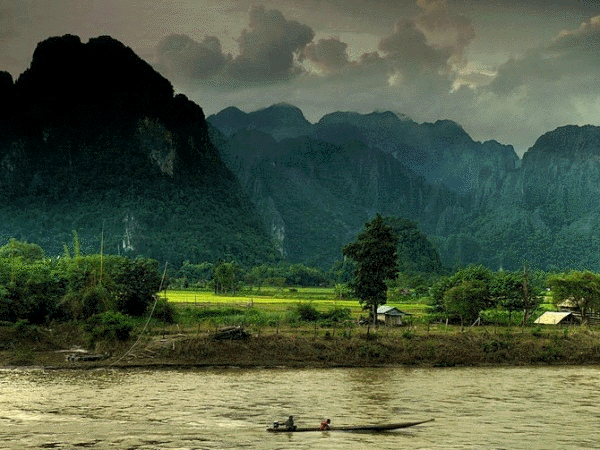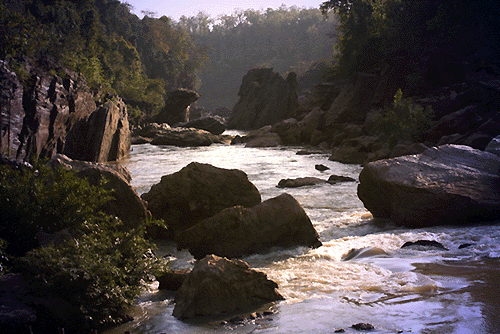Caitanya Mahaprabhu's Tirtha-yatra, Part 11
BY: SUN STAFF - 5.8 2021

Dandakaranya, Andhra Pradesh
A serial exploration of the holy sites visited by Lord Caitanya.
Dandakaranya Forest
In the summary of Sri Caitanya-caritamrta Madhya lila 9, we read about Lord Caitanya's travels to the famous tirtha of Dandakaranya:
"The Lord then visited Tapti, Mahismati-pura, Narmada-tira and Rsyamuka-parvata. He entered Dandakaranya and liberated the seven palm trees. From there He visited a place known as Pampa-sarovara and visited Pancavati, Nasika, Brahmagiri and also the source of the Godavari River, Kusavarta. Thus the Lord visited almost all the holy places in South India."
In his narration of Lord Caitanya's pilgrimage, as summarized in Madhya lila 9 and excerpted above, HDG Srila Bhaktivinoda Thakur essentially says that having visited this group of tirthas, ending with Kusavarta, the Lord's travels to 'almost all the holy places in South India' was concluded. The Dandakaranya Lord Caitanya visited is understood to be located in Nasik, Maharashtra, approximately 175 kilometers northeast of Mumbai. While this spot is generally considered to be Central India, Srila Bhaktivinoda is apparently referring to the fact that the Lord's travels through South India concluded in this region, before His party returned again to Jagannatha Puri.
There is, however, another location known as Dandakaranya, a forested area covering a large part of Central India in Madhya Pradesh, Andhra Pradesh, and Orissa. While some sources state that the Panchavati of Ramayana is at Nasik, Maharashtra but the Dandakaranya where Rama was in exile is at Koraput, Orissa, in fact Rama did live in exile in the Dandakaranya Forest at Nasik. That is confirmed by Srila Prabhupada in Krsna Book, Chapter 79, referred to later in this article. Lord Rama also built a small asrama in Dandakaranya at Nasik.
In Madhya lila 9.3.11-16, we read about the Lord's visit to Dandakaranya, and the details of His glorious pastimes there:

Dandakaranya forest in Orissa
Caitanya-caritamrta Madhya lila 9:
Text 311
dhanus-tirtha dekhi' karila nirvindhyate snane
rsyamuka-giri aila dandakaranye
SYNONYMS
dhanush-tirtha--Dhanus-tirtha; dekhi'--seeing; karila--did; nirvindhyate--in the river Nirvindhya; snane--bathing; rsyamuka-giri--at the Rsyamuka Mountain; aila--arrived; dandaka-aranye--in the forest known as Dandakaranya.
TRANSLATION
The Lord next arrived at Dhanus-tirtha, where He took His bath in the river Nirvindhya. He then arrived at Rsyamuka Mountain and then went to the forest called Dandakaranya.
PURPORT
According to some opinions, Rsyamuka is a chain of mountains beginning at the village of Hampi-grama in the district of Belari. The mountain chain begins along the bank of the river Tungabhadra, which gradually reaches the state of Hyderabad. According to other opinions, this hill is situated in Madhya Pradesh and bears the present name of Rampa. Dandakaranya is a spacious tract of land which begins north of Khandesa and extends south to Ahmadnagar, west to Nasika, and east to Aurangabad. The Godavari River flows through this tract of land, and there is a great forest there where Lord Ramacandra lived.
TEXT 312
'saptatala-vrksa' dekhe kanana-bhitara
ati vrddha, ati sthula, ati uccatara
Within that forest Sri Caitanya Mahaprabhu then visited a place called Saptatala. The seven palm trees there were very old, very bulky and very high.
PURPORT
The name Saptatala is mentioned in the Kiskindhya Chapter of the Ramayana and is described in the eleventh and twelfth sections of this chapter. TEXT 313
saptatala dekhi' prabhu alingana kaila
sasarire saptatala vaikunthe calila
After seeing the seven palm trees, Sri Caitanya Mahaprabhu embraced them. As a result, they all returned to Vaikunthaloka, the spiritual world. TEXT 314
sunya-sthala dekhi' lokera haila camatkara
loke kahe, e sannyasi----rama-avatara
After the seven palm trees had departed for Vaikuntha, everyone was astonished to see them gone. The people then began to say, "This sannyasi called Sri Caitanya Mahaprabhu must be an incarnation of Lord Ramacandra. TEXT 315
sasarire tala gela sri-vaikuntha-dhama
aiche sakti kara haya, vina eka rama
"Only Lord Ramacandra has the power to send seven palm trees to the spiritual Vaikuntha planets."
The residents of Dandakaranya who witnessed the miraculous pastime of Caitanya Mahaprabhu's liberation of the seven palm trees exclaimed that this personality must be Lord Rama, who was famous in the area since ancient times. Sri Rama appeared in Treta-yuga, more than two million years ago, and while on exile, lived in the Dandakaranya Forest for several years along with Sita Devi and Laksman. Although Lord Caitanya traveled here relatively recently, still the local residents recognized Him as Lord Rama when He liberated the seven palm trees at Saptatala.
Lord Rama's 14 year exile was not all spent at Dandakaranya, however. Approximately 11 years of that time was spent in the area of Chitrakoot. Today, pilgrims travel from around the world to the Pancavati shrine at Dandakaranya Forest in Nasik to worship Lord Rama. It is also the place where Ravana kidnapped the mayic expansion of Sita Devi.

Bathing ghats at Nasik
The name 'Pancavati' refers to five banyan trees that are associated with a pastime of Surya's. Surya was overcome by lust for Usa, his wife, and to escape him, she took the form of a horse. Surya did likewise, however, and continued to pursue her. Five young brahmana boys (Rsi kumaras) happened to see this, and were very amused. Surya became offended at their laughter, and cursed the boys to become trees. They were also blessed that they would get darshan of the Lord when He came here.
A beautiful black swayambhu (self-manifesting) Deity of Lord Rama from the Godavari River resides here at Pancavati. The Lord has one hand on His chest. Lord Caitanya Mahaprabhu came to this place and danced in ecstasy.

Swayambhu Deities of Sita Rama Laksman
The Sages of Dandakaranya
A pastime of primary significance associated with Dandakaranya is the story of the sages of Dandakaranya, who desired to experience the rasa of conjugal love with the Lord. This is described in Nectar of Devotion, Chapter 16:
"How a devotee in the form of a man can desire to become a gopi is stated in the Padma Purana as follows: In days gone by there were many sages in Dandakaranya. Dandakaranya is the name of the forest where Lord Ramacandra lived after being banished by His father for fourteen years. At that time there were many advanced sages who were captivated by the beauty of Lord Ramacandra and who desired to become women in order to embrace the Lord. Later on, these sages appeared in Goloka Vrndavana when Krsna advented Himself there, and they were born as gopis, or girl friends of Krsna. In this way they attained the perfection of spiritual life.
The story of the sages of Dandakaranya can be explained as follows. When Lord Ramacandra was residing in Dandakaranya, the sages who were engaged in devotional service there became attracted by His beauty and immediately thought of the gopis at Vrndavana, who enjoyed conjugal loving affection with Krsna. In this instance it is clear that the sages of Dandakaranya desired conjugal love in the manner of the gopis, although they were well aware of the Supreme Lord as both Krsna and Lord Ramacandra. They knew that although Ramacandra was an ideal king and could not accept more than one wife, Lord Krsna, being the full-fledged Personality of Godhead, could fulfill the desires of all of them in Vrndavana. These sages also concluded that the form of Lord Krsna is more attractive than that of Lord Ramacandra, and so they prayed to become gopis in their future lives to be associated with Krsna.
Lord Ramacandra remained silent, and His silence shows that He accepted the prayers of the sages. Thus they were blessed by Lord Ramacandra to have association with Lord Krsna in their future lives. As a result of this benediction, they all took birth as women in the wombs of gopis at Gokula, and as they had desired in their previous lives, they enjoyed the company of Lord Krsna, who was present at that time in Gokula Vrndavana. The perfection of their human form of life was thus achieved by their generating a transcendental sentiment to share conjugal love with Lord Krsna."
Lord Balarama and Nityananda Prabhu at Dandakaranya
As we've read about tirthas in previous segments, both Lord Balarama and Nityananda Prabhu visited the holy site of Dandakaranya. In Srimad-Bhagavatam 10.79.19-21 we read of Lord Balarama's travels:
"The Supreme Lord then traveled through the kingdoms of Kerala and Trigarta, visiting Lord Siva's sacred city of Gokarna, where Lord Dhurjati [Siva] directly manifests himself. After also visiting Goddess Parvati, who dwells on an island, Lord Balarama went to the holy district of Surparaka and bathed in the Tapi, Payoshni and Nirvindhya rivers. He next entered the Dandaka forest and went to the river Reva, along which the city of Mahishmati is found. Then He bathed at Manu-tirtha and finally returned to Prabhasa."
In Krsna Book, Srila Prabhupada further describes Lord Balarama's visit to Dandakaranya, in Chapter 79, 'The Liberation of Balvala, and Lord Balarama's Touring the Sacred Places'. Here, Srila Prabhupada confirms that the Dandakaranya Forest at Nasik was the place of Lord Rama's exile:
"From Cape Comorin Lord Balarama turned toward Kerala. The country of Kerala is still existing in southern India under the name of South Kerala. After visiting this place, He came to Gokarnatirtha, where Lord Siva is constantly worshiped. Balarama then visited the temple of Aryadevi, which is completely surrounded by water. From that island, He went on to a place known as Surparaka. After this He bathed in the rivers known as Tapi, Payosni and Nirvindhya, and He came to the forest known as Dandakaranya. This is the same Dandakaranya forest where Lord Ramacandra lived while He was in exile. Lord Balarama next came to the bank of the river Narmada, the biggest river in central India. On the bank of this sacred Narmada is a pilgrimage spot known as Mahismati Puri. After bathing there, according to regulative principles, Lord Balarama returned to Prabhasatirtha, wherefrom He had begun His journey."
The travels of Nityananda Prabhu are described in Caitanya Bhagavata:
"Gaya, Kasi, Prayaga, Mathura, Dvaraka, and Nara-Narayana asrama were magnanimously visited. He further visited the place of the Buddhists, the residence of Vyasa, as well as Ranganatha, Setubandha and the Malaya Hills. He then went to Anantapura and fearlessly travelled through uninhabited forests. He visited the Gomati, Gandaki, Sarayu and Kaveri Rivers, and travelled to Ayodhya and the Dandakaranya forest. He went to Trimalla, Vyenkatanatha, Sapta-Godavari, the abode of Mahesa, and Kanyakumari. He visited the Reva, Mahismati, Malla-Tirtha, and Haridvar, where the Ganga descended in ancient times. In this way Nityananda Raya, after travelling to all the holy places, returned to Mathura."






































